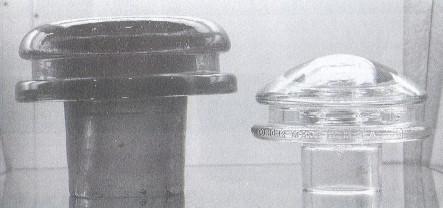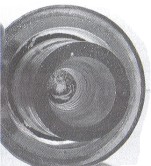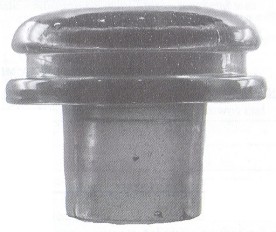Mac's Believe It Or Not!
by John McDougald
Reprinted from "Crown Jewels of the Wire", November 2000, page 16
CD 176.9
The "Toadstool" --
if that means it's larger than a
"Mushroom"
It has been several months since we have been able to announce the assignment
of a new CD number for a threaded pintype from the United States, but this month
we have one, with pictures. Actually the story behind this piece goes back
nearly 15 years, and unbeknownst to me at the time, I was part of the history.
In the mid-1980's, I bought the collection of Steve Bunish from Marion,
Indiana. Steve was a well known collector in the local area, but was not well
known in the hobby in general and had not actively participated in the organized
hobby for many years. I had gotten his name from Ken Roach of Muncie, Indiana
who had been one of the early diggers in the Muncie dump. Ken was one of the big
Midwest dealers back in the late 60's and early 70's, and Carol and I had a
chance to visit with him for the first time in the late 70's, right before the
old off-site Muncie dump was covered up. He gave us directions to the dump, and
the Carol and I had fun with the kids picking up shards of old Hemingray
products right off the ground. Ken had a great collection, not to mention the
largest grouping of CD 232.1's ever assembled. Oh well, that's another story.
Anyway, a number of years later, Ken suggested that I contact Steve Bunish as
someone who might be interested in selling his collection, and I did.
Steve had
a very nice general collection, including a lot of experimental Hemingrays like
the E-1, E-2, E-3, several opalescents and a number of other interesting dump
specimens. The deal was closed, the insulators were packed, and on our way out
the door, Steve said, "Oh, I might have one more piece you may be
interested in." He opened a cabinet in his dining room and out popped a
lead Harloe claw. It had a non-standard pinhole (it looked like the threads had
been cut in as an afterthought, but the piece had been poured in the Harloe
mold, without a doubt. The embossing was pretty clear, and the shape was unmistakable. After some brief
negotiations, I was the new owner. I know, you're wondering when the new CD
shows up - just hold on.
About this time, Bob Harding, Columbus, Ohio, was doing
some serious digging and was specializing in Hawley/Harloe, in addition to some
other areas of interest. He got wind of the lead Harloe I had acquired, and he
just had to have it. Bob was a great trader, and so I suggested he bring up his
traders and we'd see what kind of a deal we could make. Within a week, he was at
the house (we were still in Ohio then) with the most unusual cross section of
trading stock I have ever seen.
Again, after prolonged negotiations, Bob left
with the Harloe, and I looked at what had been left behind. There was a handful
of nice color pieces, including a CD 164 McLaughlin in citrine. There was one of
those Hemingray paperweights, about six inches in diameter with drip points in
light aqua (I think two of them have shown up in the hobby - sorry, I don't have
a picture) and a horribly damaged piece of glass that Bob had dug. It had a big
"H" in a square on the dome, a threaded pinhole and chipping all
around the exterior which indicated that a substantial portion of the
"piece of glass" (I wasn't even ready to call it an insulator then)
was missing.


I kept that piece for a number of years and finally sold it to Butch
Haltman. I had never even thought of looking for a CD assignment since so much
of the insulator wasn't there. Butch bought it on speculation that someday a
whole one might be found, and the specimen might fill a hole in his CD
collection. Several more years passed, and Butch tired of waiting for any sign
of a new CD. The piece had many Hemingray characteristics, and Butch sold it to
Bill Meier at the 1996 Long Beach National. Again, this was a speculation
purchase on Bill's part, in anticipation of possibly confirming Hemingray as the
manufacturer at some time in the future.
More time passes, but on another
front, Roger Lucas and Bob Stahr have turned up some interesting chards in the
on-site Hemingray factory dump. They appear to be off clear versions of the
Whitall Tatum mushroom (CD 176) on steroids. There were striking similarities
between what Roger and Bob turned up in the dump and the piece that now resided
in Bill Meier's collection. The major exception was color. Bill's piece was dark
aqua compared to the very light pieces that were coming out of the dump.
Again,
a period of silence and then, out of the blue, several of us are contacted by a
non-insulator collector who has an unusual piece. As pictures were exchanged and
discussed, it became clear that this was the first complete specimen of the
"Hemingray mushroom." As you can see from the comparison shots below,
this piece is much larger than the Whitall-Tatum "mushroom". In addition, the comparison shot between the
piece I once owned and the complete Hemingray mushroom shows that they were
molded differently. The specimen has a flared inner skirt while the complete
piece is much straighter. This piece went up for auction several weeks ago, and
it now resides in the collection of a well known insulator specialist.

New Hemingray CD 176.9 and CD 176 by Whitall Tatum.
The new
insulators went along with the pictures and the history to Mr. N. R. Woodward as
this story was unfolding, and after deliberating, Woody assigned CD 176.9 to the
new piece.
In his response to me, Woody commented as follows regarding the
comparison of the new piece with the CD 176 Whitall Tatum: "The L. T.
Wilson patent covers the CD 176 Whitall Tatum No. 12. Although some of its
features are the same, and probably some of the same people were working on the same theories, the L. T. Wilson patent finds a clever way to
limit the size of the unit - the specification that the wire groove must be more than twice the diameter of the pinhole. The desire to make an insulator
using a minimum amount of material is brought out in the 3 pages of text. The
monstrosity made at Hemingray and tested on the rooftop test rack does not meet
those requirements. You are right about the pinhole. Obviously it was intended
for use as a bonded pair. I can't tell from the photograph if this feature was
used in the rooftop test."

New Hemingray CD 176.9 and original "specimen".


CD 176.9
I am always excited to recognize the addition of a new find to our growing
list of insulator styles.
Many of the old timers in this hobby continue to remind us that we have just
uncovered the tip of the iceberg with respect to the variety of insulators that
have been manufactured. Finds like this continue to make a believer out of
me.... Believe It or Not!
|
